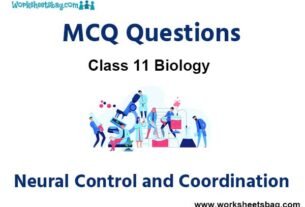Please refer to MCQ Questions Chapter 3 Liberalisation, Privatisation and Globalisation: An Appraisal Class 11 Economics with answers provided below. These multiple-choice questions have been developed based on the latest NCERT book for class 11 Economics issued for the current academic year. We have provided MCQ Questions for Class 11 Economics for all chapters on our website. Students should learn the objective based questions for Chapter 3 Liberalisation, Privatisation and Globalisation: An Appraisal in Class 11 Economics provided below to get more marks in exams.
Chapter 3 Liberalisation, Privatisation and Globalisation: An Appraisal MCQ Questions
Please refer to the following Chapter 3 Liberalisation, Privatisation and Globalisation: An Appraisal MCQ Questions Class 11 Economics with solutions for all important topics in the chapter.
MCQ Questions Answers for Chapter 3 Liberalisation, Privatisation and Globalisation: An Appraisal Class 11 Economics
Question. GST has been implemented from
a) April 1, 2018
b) January 1, 2018
c) January 1, 2017
d) July 1, 2017
Answer
D
Question. The economic reforms were intended to take the Indian economy into three specific directions which are
a) LPG
b) DPG
c) LDG
d) DLP
Answer
A
Question. In which year did the disinvestment process in Public Sector Enterprises in India start?
a) 2018
b) 2000
c) 1990
d) 1991
Answer
D
Question. Which of the statements is most suitable to describe direction of India’s foreign trade?
a) Trade with OPEC regions has improved substantially
b) Importance of OECD countries in exports of India has increased
c) UK occupies first place in India’s exports
d) Import from SAARC has increased
Answer
A
Question. Under the industrial policy of 1991, the number of industries reserved for the public sector have been reduced from 17 to
a) 6
b) 8
c) 3
d) 5
Answer
B
Question. Steps taken towards liberalisation
a) Delicensing of industries
b) Dereservation of industries
c) Delicensing of imports
d) All of these
Answer
D
Question. LQP raj refers to
a) license, quota, privatisation raj
b) liberalisation, quota, permit raj
c) license, quota, permit raj
d) license, quarter, privatisation raj
Answer
C
Question. New plan of action by government to influence production and capital formation activities in the country
a) NEP
b) NED
c) NEG
d) NPP
Answer
A
Question. Sale tax and excise duty are examples of
a) Direct tax
b) Indirect tax
c) Both
d) None
Answer
B
Question. The measures taken under NEP are called
a) Economic development
b) Economic growth
c) Economy
d) Economic reforms
Answer
D
Question. Which of the following is an example of direct tax
a) Corporation tax
b) Excise duties
c) Sales tax
D) None
Answer
A
Question. Privatization can be achieved by :
a) Leasing
b) Franchising
c) Contracting
d) All of these
Answer
D
Question. MUDRA Bank was set up to meet the credit needs of the
a) farmers
b) small enterprises
c) large enterprises
d) exporters
Answer
B
Question. Trade between two countries is knows as:
a) Bilateral trade
b) Multi lateral trade
c) Both a) and b)
Answer
A
Question. Inward foreign direct investment is useful because:
a) Brings in foreign exchange
b) Brings in modern technology
c) Brings in management expertise
d) All the above
Answer
D
Question. Market in which the securities of government and public companies are traded
a) Foreign market
b) Stock exchange
c) Financial market
d) SEBI
Answer
B
Question. Inwards foreign direct investment is useful because
a) Brings in management expertise
b) Brings in modern technology
c) Brings in foreign exchange
d) All
Answer
D
Question. Make in India programme was launched in
a) 1991
b) 2014
c) 2015
d) 2016
Answer
B
Question. Reasons which highlight the importance to privatisation
a) Decline in private monopoly
b) Increase employment due to exit policy for sick public enterprises
c) Reduce the cost by minimising wastages
d) Favour the objective of social welfare
Answer
C
Question. Which policy do these changes belong to
i) SLR and CRR reduced by RBI to increase the availability of funds
ii) Bank rate reduced
iii) SEBI made statutory
a) Monetary policy
b) Foreign trade policy
c) Fiscal policy
d) None
Answer
A
Question. When was WTO established?
a) 1996
b) 1998
c) 2000
d) 1995
Answer
D
Question. When did the Gulf Crisis take place?
a) 1985
b) 1990-91
c) 1995
d) 1975
Answer
B
Question. How many industries are entirely reserved for the public sector?
a) 6
b) 10
c) 2
d) 4
Answer
C



